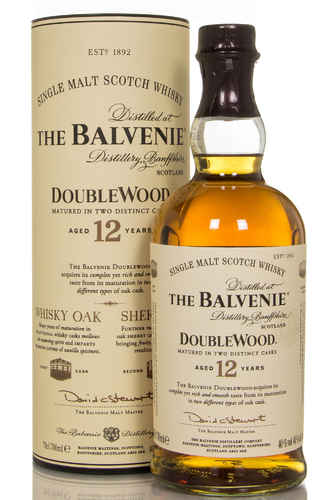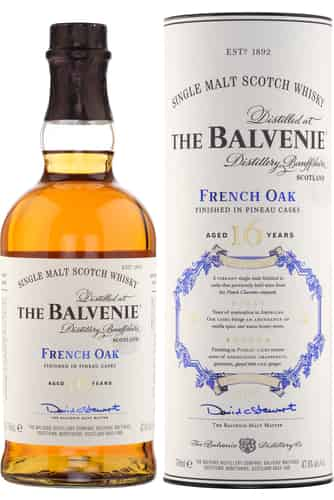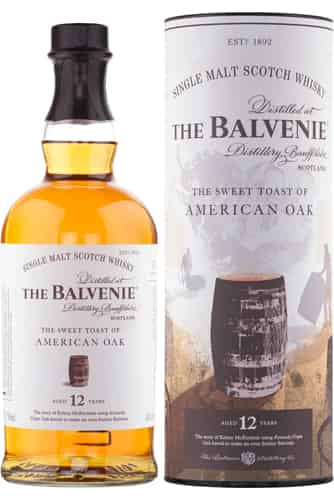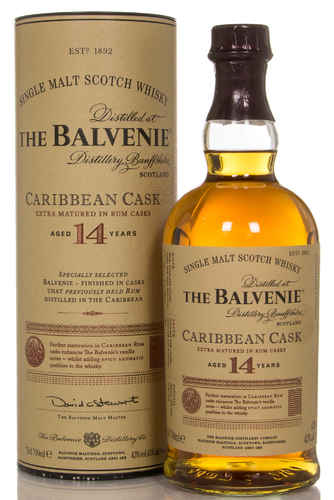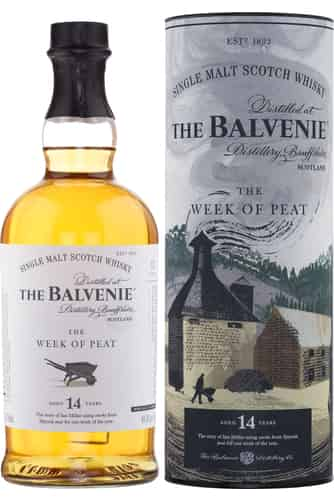Balvenie
- Save
16.00 €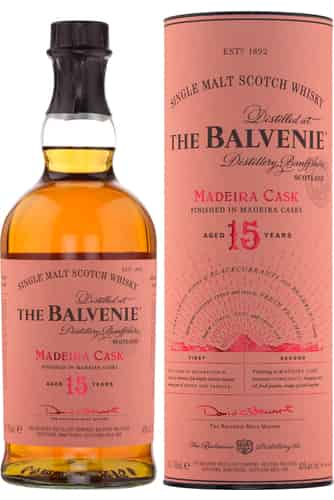
Balvenie 15 Year Old Madeira Cask
70 cl, 43%In stock143.20 €159.20 € 
Balvenie The Creation of a Classic
70 cl, 43%In stock68.80 €![]()
Balvenie 12 Year Old DoubleWood
70 cl, 40%In stock55.20 €![]()
Balvenie 16 Year Old French Oak
70 cl, 47.6%In stock182.40 €![]()
Balvenie 12 Year Old Sweet Toast of American Oak
70 cl, 43%In stock60.00 €![]()
Balvenie 14 Year Old Caribbean Cask
70 cl, 43%Out of stock79.20 €![]()
Balvenie 14 Year Old The Week of Peat
70 cl, 48.3%Out of stock71.20 €
Sorry, we didn't find anything. Please try changing your search criteria.
Balvenie History
In the famous old whisky town of Dufftown lies Balvenie, just a few steps away from Glenfiddich distillery. Whilst the distilleries share a founder, owner and water source, they are very different in style, with the Balvenie renown for its subtly sweet and rich whiskies, with highlights of honey and nuts. The distillery has released many cult classics- most notably the stellar ‘Tun’ lines.
With a history dating back to 1892, when William Grant founded the distillery as the sister operation to Glenfiddich, Balvenie has been producing some of Speyside’s finest whisky ever since. Named after the nearby towering ruins of Balvenie castle, the distillery has maintained a close connection to the local land- fuelling its fires with hand-cut peat from nearby environs. This is just another example of a distillery that does things the ‘old-fashioned’ way, as it also maintains floor maltings, adding a unique element to the distillery’s spirit. Indeed, the distillery is known as the ‘Complete Distillery’ as every process- from malting the barley, to bottling the spirit- occurs on site at Balvenie. To this end they employ a coppersmith and cooper onsite for barrel making and still repairs, procedures that are often outsourced by other distilleries. They say this ensures that the barrels and the stills, the two most important distillery features for the flavours of a whisky, are kept in pristine condition.
Balvenie takes this artisanal approach to everything it does, producing beautiful bottles and packaging of the highest quality, showcased most spectacularly in their 50-year-old expression, which was bottled in hand blown glass, and packaged in a specially designed tube which showcased local varieties of wood, hand crafted by an expert carpenter. This does not mean, however, that the distillery is stuck in the past, with only "the traditional way", rather, through its expansive and interesting use of casks and vattings – as demonstrated by their fabulous ‘Tun’ bottlings, which also pushed the boundaries of none age stated malt whiskies.
Timeline
-
1839
William Grant is born, a member of the historic Clan Grant family of Speyside.
-
1866
William joins a local distillery (rumoured to be Mortlach) as a bookkeeper. Over the 20 years he worked there he gained a taste for whisky and a knowledge of the production techniques, eventually rising to be the distillery’s manager and resolving to build his own distillery when he got the chance.
-
1886
William Grant had long harboured an ambition to build a distillery, something he finally achieved in 1886, building Glenfiddich.
-
1887
The first spirit trickles from Glenfiddich’s copper stills- bought second hand from Cardhu distillery- on Christmas day of this year.
-
1892
Grant expands his portfolio by building his second distillery, in many ways a sister distillery to Glenfiddich, Balvenie. Originally known as Glen Gordon (after another branch of the Grant family), Balvenie is founded with equipment from Lagavulin and Glen Albyn, and the rebuilding of the Balvenie New House- a mansion originally built in the 1700s.
-
1893
The first Balvenie spirit runs from the stills in May of this year.
-
1898
The Grant begins to bottle its own whisky after the family’s foremost customer, the Pattisons blending house, goes bankrupt. One of the Grant’s first blends, Standfast, quickly achieves popularity and becomes one of their flagship brands.
-
1903
The company that owns Glenfiddich and Balvenie changes its name to William Grant & Sons, which has remained the same ever since.
-
1909
In a forward thinking marketing move typical of the Grant operation, Charles Gordon, who married William’s daughter Isabella, begins travelling the world selling the whisky.
-
1914
Gordon’s work pays off as he has set up distribution systems and networks of contacts in over 30 countries.
-
1957
After many years of steady distilling (despite two world wars and the battering of prohibition in America), which saw most of the Balvenie’s product go into Grant’s Standfast and "Grant’s" blend, the distillery expands its stills from 2 to 4.
-
1962
A certain young man named David Stewart begins work with William Grant and Sons as an apprentice.
-
1963
Glenfiddich begins to be sold as a Single Malt, but not Balvenie… Yet!
-
1965
The distillery is expanded again as another two stills (one spirit and one wash) are added, bringing the total to 6.
-
1971
This is followed by another expansion of two stills, meaning that the Balvenie now runs 8 stills in total… It is almost like they are gearing up for something, what could that be?
-
1973
Following the precedent set a decade before by Glenfiddich, Balvenie begins to be sold as a single malt beyond Scotland, and the first distillery or "official" bottlings are released. This marks another significant step by the Grant’s in the promotion of Single Malts as a category of whisky, and as specialised, gourmet spirit.
-
1982
Further indicative of Grant’s marketing of Single Malts as a luxury good is the release of Founder’s Reserve, a Balvenie expression (now exceedingly rare and collectible) sold in bottles designed to recall the shape of high-class Cognac bottles.
-
1990
A third Grant’s distillery, and sister distillery to both Glenfiddich and Balvenie, is constructed nearby, named Kininvie.
-
1992
The distillery celebrates 100 years since its foundation. Dave Steward has also now been working at Balvenie for 30 years.
-
1996
Balvenie first releases its Vintage bottlings, and its famous Port Cask expressions, which have gone on to be a flagship line for the distillery.
-
2001
Again demonstrating the distilleries willingness to experiment with cask and flavours, Balvenie releases an Islay Cask expression, matured for 17 years in ex-bourbon barrels, and finished for a few months in barrels that previously held a heavily peated Islay Scotch. The resulting whisky was extremely interesting, with the typical polished honey notes of Balvenie supported by a subtle smoke and slight peaty tang.
-
2002
Balvenie releases one of their most famous, collectable and brilliant bottling. A 50 year old whisky, which had rested in sherry casks since 1952. Only 83 bottles were released, and they were priced at £6,000 each – a price that today seems somewhat modest! This was a tour de force bottling that fully established Balvenie as a top-class whisky producer.
-
2004
A 30 year old bottling of Balvenie is released to mark the 30th anniversary of David Stewart becoming the Malt Master of the distillery.
-
2005
One of the Balvenie’s most popular bottlings first hits the shelves- the 14 year old Rum cask, now known as the Caribbean Cask. For a while this was bottled as the "Cuban Cask"- though because of the trade embargo between American and Cuba these could never be sold in the States.
This year also sees the releases of one of Grant’s most important products- Monkey Shoulder Blended Malt. This whisky, a blend of Balvenie, Kininvie and Glenfiddich, was originally conceived as something of a side-project to the main operation of distilling malt whisky, yet it has proved to be one of the run away successes of Grant’s recent history, and in 2014 over 200,000 cases of Monkey Shoulder whisky was sold.
-
2008
After many years of distilling with four sets of two stills, another three stills – one wash, and two spirit – were added to the distillery. Indeed, there are so many stills at Balvenie now that they are split across two rooms!
-
2010
Balvenie releases the oldest member of its standard range- the 40 year old. In the same year, over a million bottles of Balvenie Single Malt were sold, with the distillery amongst the top ten bestselling Single Malts in the world.


